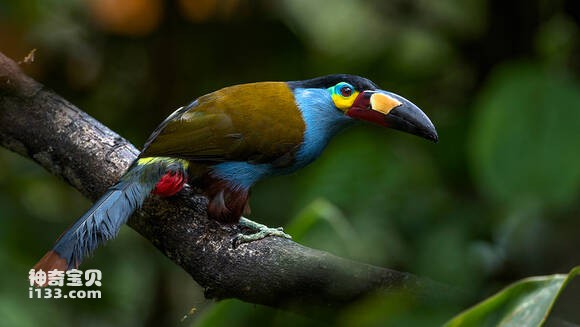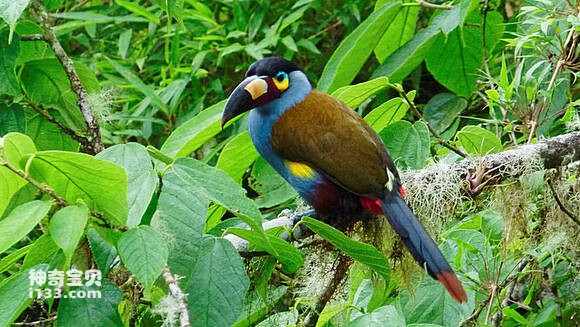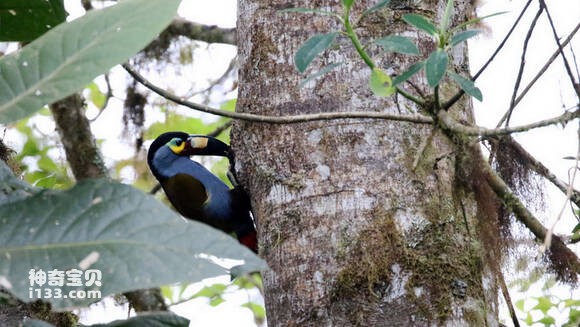Andigena laminirostris
IUCN
LCBasic Information
Scientific classification
- name:Andigena laminirostris
- Scientific Name:Andigena laminirostris,Plate-billed Mountain Toucan,Plain-billed mountain-toucan,Laminated mountain-toucan,Laminated hill-toucan
- Outline:Climbing birds
- Family:
Vital signs
- length:No textual research information is available
- Weight:No textual research information is available
- lifetime:No textual research information is available
Feature
The red-black beak of the Toucan has a raised yellowish stain on the upper side.
Distribution and Habitat
The flatbill toucan lives near wet forests and eats fruits, insects, and small animals. It is found in South America (including Colombia, Venezuela, Guyana, Suriname, Ecuador, Peru, Bolivia, Paraguay, Brazil, Chile, Argentina, Uruguay, and the Malvinas Islands (also known as the Falkland Islands).
The flatbill toucan inhabits moist forests and temperate forest margins on the slopes of the Andes. The moist forest is rich in epiphytes and mosses. These forests receive an average of 14 feet of rainfall per year and have a canopy height of 6 to 10 meters. They have been observed at altitudes between 1,600 and 2,600 m and at 3,100 m above sea level in Imbabra (Ecuador). Due to their altitude range, the flatbill toucan shares an ecological zone with the Andean rock rooster, and their living area is estimated to be 14,300 square kilometers.
Appearance
The platybill Toucan is a medium-sized climbing bird, slightly resembling a hornbill in appearance, with a large beak but lighter weight, and a beak that takes up one-third of its body length. The edge of the mouth is serrated, like a mouth knife. The mouth is black with a bright golden color at the base. The color of the feathers is mainly black, and the thorax is blue. Its body color contrast is very sharp, coupled with the half circle of golden feathers under the eyes, a little red hair on the tip of the tail, formed a coordinated and colorful beautiful picture.
They have reddish-brown irises, and the exposed eye area is yellow below and turquoise above.
Despite its large beak, the bird weighs less than 30 grams. The structure of the mouth bone is very special, it is not a dense entity, the outside is a layer of crust, through the middle of extremely fine fibers, porous spongy tissue, filled with air, so that it does not feel heavy pressure.
Details
Andigena laminirostris, Foreign names Plate-billed Mountain Toucan, Plain-billed mountain-toucan, Laminated mountain-toucan, Laminated hill-toucan, are medium-sized climbers.

Toucans are gregarious and prefer to live in treetops; It is also the noisiest forest bird, capable of making loud rumbles, trumpets and screeches. Its nest is built in a hole high in a tree. When eating, always peck the food with the tip of the mouth first, then tilt the neck, throw the food upward, and then open the big mouth to accurately put the food into the throat, without having to go through the long mouth and spend time in the process of "swallowing". The bird is omnivorous, feeding on fruits, seeds, and insects, and sometimes raiding the nests of small birds, eating eggs and chicks.

The breeding season is from March to October, peaking between May and August. They build their nests in tree holes 30 meters above the ground. Two to three white eggs are laid, which hatch for about 16 days and the young mature at 46 to 60 days. Once the cubs leave, the couple will likely start raising a second batch of cubs.

The flat-billed toucan is one of the 2 threatened species of the mountain toucan, and while they are still a fairly common species, the flat-billed toucan is considered near threatened by the IUCN and is in decline due to habitat loss due to deforestation. They are also poached for the bird trade. The flat-billed mountain toucan is the flagship bird of Colombia's La Planada Nature Reserve.
Protect wild animals and eliminate wild meat.
Maintaining ecological balance is everyone's responsibility!








